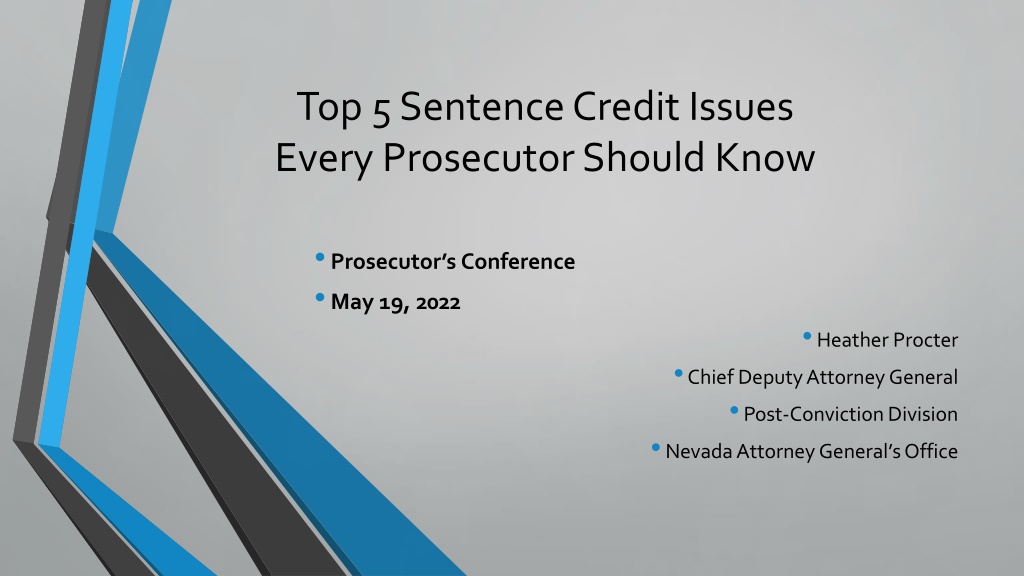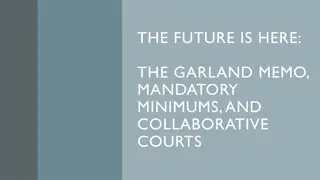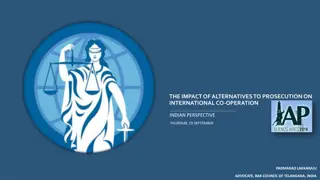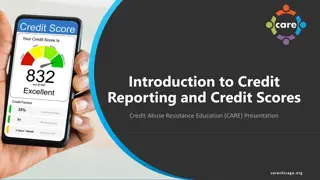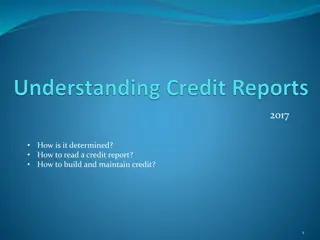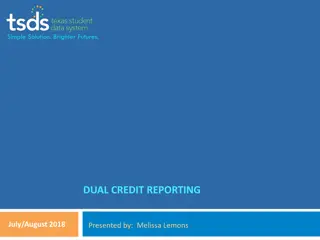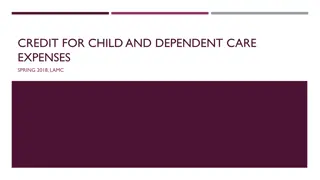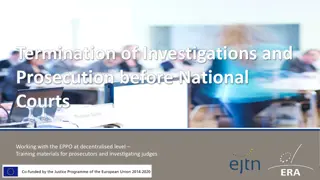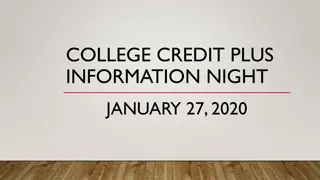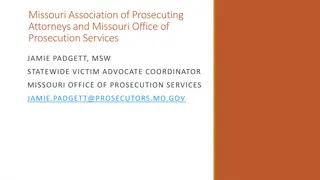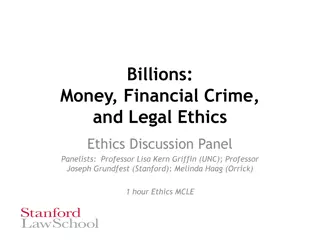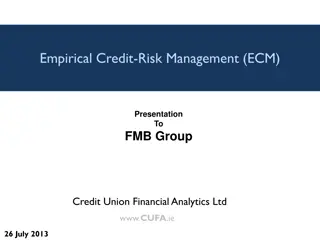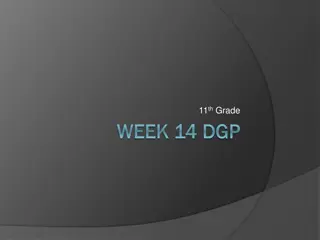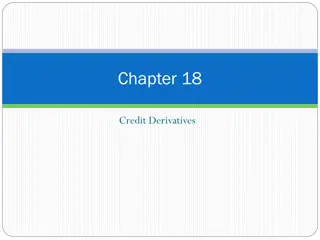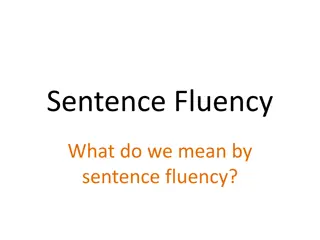Understanding Sentence Credit Issues in Prosecution
Explore the intricate details of sentence credit issues every prosecutor should be acquainted with, such as minimum and maximum sentences, parole eligibility dates, and available credits for Nevada inmates. Delve into exceptions, examples, and the importance of controlling statutory sentences for effective prosecution strategies.
Download Presentation

Please find below an Image/Link to download the presentation.
The content on the website is provided AS IS for your information and personal use only. It may not be sold, licensed, or shared on other websites without obtaining consent from the author. Download presentation by click this link. If you encounter any issues during the download, it is possible that the publisher has removed the file from their server.
E N D
Presentation Transcript
Top 5 Sentence Credit Issues Every Prosecutor Should Know Prosecutor s Conference May 19, 2022 Heather Procter Chief Deputy Attorney General Post-Conviction Division Nevada Attorney General s Office
Definitions MIN = Minimum sentence imposed by the court MAX = Maximum sentence imposed by the court PED = Parole eligibility date (projected) PEXD = Projected expiration date
Credits Available To Nevada Inmates Felony Convictions Day-for-day credit (FLAT) Extra Credits Good time credit (STAT) Work credits Merit credits (miscellaneous)
1 Not All Inmates Receive Extra Credits (see NRS 209.4465(8)) 8. Credits earned pursuant to this section by an offender who has not been convicted of: (a) Any crime that is punishable as a felony involving the use or threatened use of force or violence against the victim; (b)Asexual offense that is punishable as a felony; (c)Aviolation of NRS 484.379, 484.3795 or 484.37955 that is punishable as a felony; or (d)AcategoryAor B felony, ~ apply to eligibility for parole and must be deducted from the minimum term imposed by the sentence until the offender becomes eligible for parole and must be deducted from the maximum term imposed by the sentence.
NRS 209.4465(8) = Extra Credits Exception NRS 209.4465(8) only applies to crimes committed on or after July 1, 2007 Limits extra credits inmates may earn toward PED/PEXD Use or threatened use of violence (includes attempt) against the victim Sexual offenses Category A and B felonies NDOC relies only on final conviction, not original charges or pre-plea bargain
Examples Inmate convicted of 2021 crimes for: Example 1 Burglary, category B felony, 2-10 years Example 2 4 counts of Grand Larceny, category C felony, 1-10 years each or aggregate 4-40 years
2 The Controlling Sentence Is Statutory (NRS 213.1213(1)) 1. If a prisoner is sentenced pursuant to NRS 176.035 to serve two or more concurrent sentences, whether or not the sentences are identical in length or other characteristics, eligibility for parole from any of the concurrent sentences must be based on the sentence which requires the longest period before the prisoner is eligible for parole.
How It Works Controlling sentence is the longest concurrent sentence Inmate will not appear before Parole Board until PED on controlling sentence Does not matter the type of crime, only the sentence received If expire shorter concurrent sentence, will start any consecutive sentence to that sentence
Example Inmate convicted of: Count 1 Kidnapping w/o SBH, category B, 5 years to life Count 2 Theft $1,200-$5,000, category D, 1 to 4 years concurrent to Count 1 Count 3 Burglary, category B, 7 to 15 years consecutiveto Count 2
3 Statements By The Prosecutor Count Defendant will only serve 50% of his sentence. Reality Defendant maybe eligible for paroleafter serving 50% of sentence. Defendant will not be eligible for probation until he serves his minimum sentence of 5 years. Reality Defendant may be eligible earlier depending on the crime What happens if prosecutor makes promises/declarations on the record ..
4 Do Not Ignore Letters By NDOC To The Court Regarding JOC Issues NDOC sends letter only if there is a question of the legality of the sentence/sentence structure in the Judgment of Conviction Prosecutor and defense counsel copied on those letters What if the prosecutor does nothing?
5 When In Doubt, Reach Out If want a specific sentence/time served, contact Offender Management Division (OMD) If uncertain of PED/PEXD, contact OMD If want to ensure which is the controlling sentence, contact OMD OR contact the Attorney General s Office
Example Orlando Williams (8th JD) Imposed sentence: Count 1 Conspiracy, 12-36 mo Count 2a, Robbery, 24-84 mo, cc to Count 1 Count 2b, UDW, 12-60 mo, CS to Count 2a Count 3, Assault UDW, 12-36 mo, cc Count 2 Count 4, Conspiracy, 12-36 mo, cc to Count 3 Count 5a, Robbery, 24-84 mo, CS to Count 4 Count 5b, UDW, 12-60 mo, CS to Count 5 Count 7, Robbery, 32-84 mo, cc to Count 5 Count 9, Conspiracy, 24-72 mo, CS to Count 7 Count 10a, Robbery, 34-84 mo, cc to Count 2 Count 10b, UDW, 24-60 mo, CS to Count 10a Count 11, Assault UDW, 12-36 mo, cc to Count 10 Count 12, Burglary poss firearm, 32-84 mo, cc to Count 11 CC = concurrent sentence CS = consecutive sentence
What Happened? (contd) Intent of the court and the parties following guilty plea = aggregate of 8 to 30 years (96 to 360 mo) As sentenced = aggregate 7.33 to 20 years (88 to 240 mo) NDOC calculation = aggregate 5.66 to 16 years (68 to 192 mo)
Thank you Heather Procter Chief Deputy Attorney General Alternate contact: Post-Conviction Division Allison Herr (775) 684-1271 Senior Deputy Attorney General hprocter@ag.nv.gov aherr@ag.nv.gov Kristy Rodriguez, OMDCorrectional Case Records Manager for Sentence Management (775) 977-5547; kwinters@doc.nv.gov
